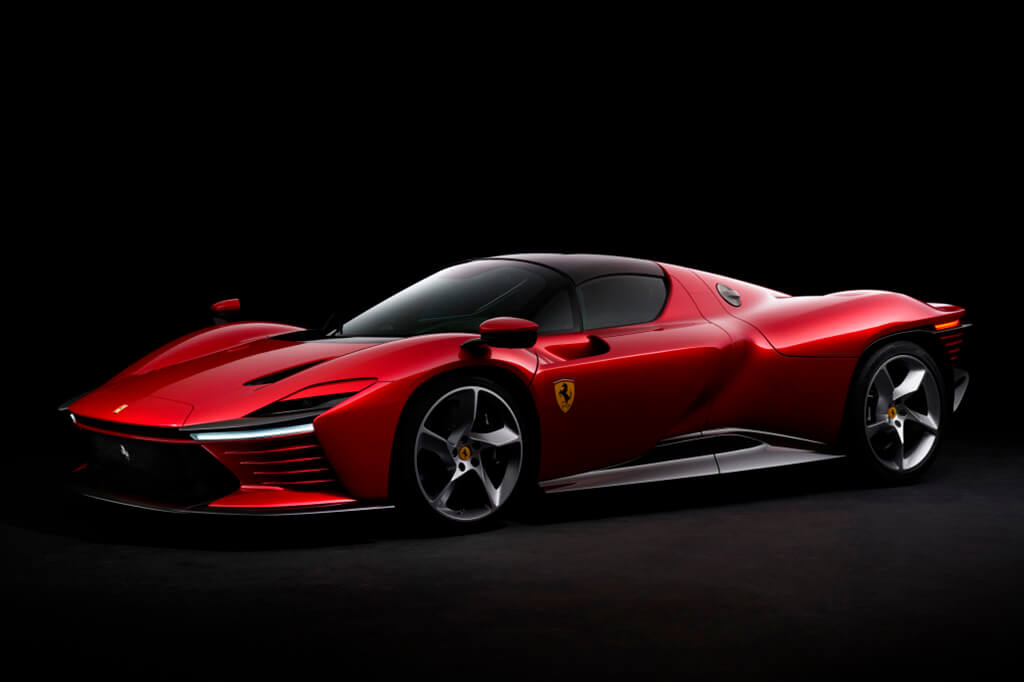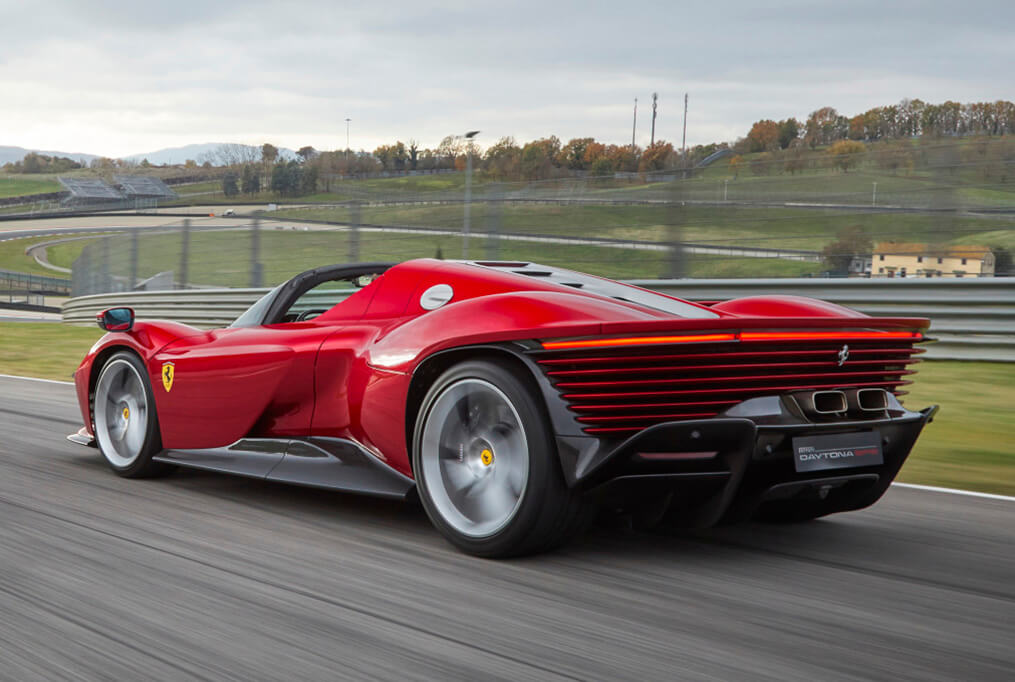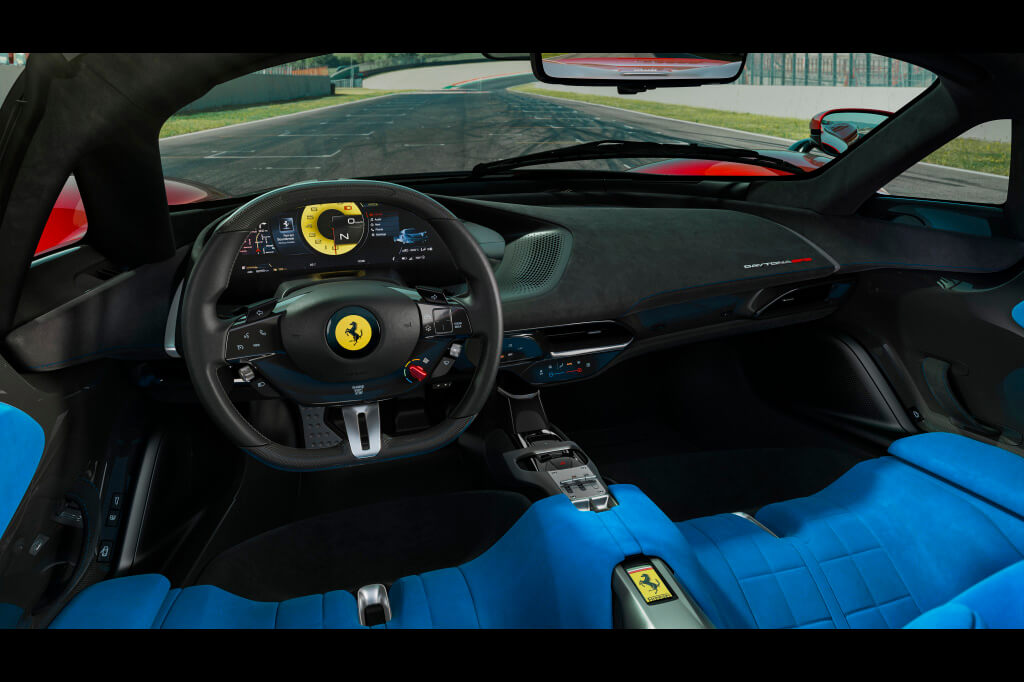Ferrari Daytona SP3
Description
In November 2021, at the Ferrari Finali Mondiali racing festival, the promised supercar of the Icona series was presented – already the third (after the Monza SP1 and Monza SP2 speedsters released in October 2018). The car was built in honor of the Italian brand's victory at the 24 Hours of Daytona marathon in 1967.
Like other models of the Icona family, the Ferrari Daytona SP3 is planned to be released in a limited edition of 599 copies at a price of about 2 million euros each. At the same time, according to the company’s commercial director Enrico Galliera, all copies were immediately sold out. 499 cars were bought by owners of Monza SP1 and SP2 cars, the remaining 100 were sold to select collectors. The delivery time for the supercar ranges from 30 to 43 months.
Engine
Unlike the La Ferrari Aperta model, on which the Daytona SP3 is based, it uses not a hybrid power plant, but an internal combustion engine - a centrally located 6.5-liter naturally aspirated V12, known as the F140 HC. In fact, this is a unit from the Ferrari 812 Competizione, which has received numerous modifications to the intake and exhaust systems. Ferrari claims that the Daytona SP3 engine is the most powerful naturally aspirated engine in the history of the brand: it develops 840 hp. at 9250 rpm and 697 Nm at 7250 rpm. The motor can spin up to 9500 rpm.
Transmission
Torque is transmitted to the rear axle through a 7-speed dual-clutch robotic gearbox.
Dynamics
The car can accelerate to 100 kph in just 2.85 seconds, and to 200 kph in 7.4 seconds. The maximum speed exceeds 340 kph.
Chassis
The body and chassis of the supercar are built on the basis of a carbon monocoque from the above-mentioned La Ferrari Aperta using composite materials (for example, carbon fiber and Kevlar), which made the car's structure lighter.
The unique five-spoke wheels are fitted with Pirelli P Zero Corsa tires, which were developed specifically for this model.
Brake system
In addition to impressive dynamics, the Daytona SP3 boasts a racing character, which is supported by advanced electronic assistants, including the latest version of the Ferrari SSC (Side Slip Angle Control) system and Ferrari Dynamic Enhancer technology, which is responsible for regulating pressure in the brake system.
The carbon-ceramic brake system has brake discs with a diameter of 398 mm at the front and 380 mm at the rear.
Exterior
Designer Flavio Manzoni was responsible for the appearance of the Ferrari Daytona SP3. Italian designers were guided by classic sports cars such as the Ferrari P3/4, P330 and 412P, which competed in marathons.
From the front, the supercar attracts attention with a pronounced splitter, flaps, a sharp and at the same time low “nose,” as well as very rounded wings. It also received spectacular opening LED headlights, butterfly wing doors and a targa roof, and side mirrors are mounted directly on the front wings. The rear of the new Ferrari Daytona SP3 looks most impressive. At the rear there are horizontal strips of LED lights, under which there are spectacular “blade-blinds”. Plus, the car has a stylish metal engine cover and a striking carbon diffuser with a pair of large rectangular exhaust pipes.
A separate point of pride for Ferrari is passive aerodynamics (active elements are completely absent): in this regard, the Daytona SP3 is supposedly superior to all other models of the brand. To achieve this result, the developers used a number of solutions. In particular, the car received a pair of air ducts under the bottom, which are connected to the rear blinds and help to increase the downforce generated at speed.
Interior
The Ferrari Daytona SP3 interior features fixed seats that are visually integrated with the central tunnel and even extend onto the side sills. This solution is reminiscent of racing cars from the 1960s. The seats have a bold blue finish, while the dashboard features a minimalistic design and is covered in black Alcantara. In front of the driver is a curved 16.0-inch digital instrument panel (similar to the SF90 Stradale), which also controls the multimedia system. The supercar's steering wheel is similar to the one installed on La Ferrari. It has a Manettino toggle switch for switching driving modes, as well as buttons on the side spokes that give access to 80% of the functions.
Sources
Specification
| Bodywork | |
|---|---|
| Presentation | |
| Years of production |
2021
|
| Produced (pcs.) |
599
|
| Body type |
тарга
|
| Number of doors |
2
|
| Number of places |
2
|
| Engine | |
|---|---|
| Engine type |
бензиновый
|
| Engine location |
центральное, продольное
|
| Engine model |
Ferrari F140 HC
|
| Cylinders |
V12
|
| V-angle |
65°
|
| Capacity (cc) |
6496
|
| Power output (hp / kW /) |
840 /
618 /
|
| at rpm |
9250
|
| Torque (N·m) |
697
|
| at rpm |
7250
|
| Redline (rpm) |
9500
|
| Bore (mm) |
94,0
|
| Stroke (mm) |
78,0
|
| Compression |
13,6
|
| Number of valves |
4/48
|
| Valvetrain |
DOHC
|
| Block material |
алюминиевый сплав
|
| Dry sump |
да
|
| Fuel system |
прямой впрыск
|
| Turbocharger |
—
|
| Specific | |
|---|---|
| Specific output (hp/litre) |
129,31
|
| Specific output (hp/tonne) |
565,66
|
| Specific output (kg/hp) |
1,77
|
| Specific torque (N·m/litre) |
107,30
|
| Specific torque (N·m/tonne) |
469,36
|
| Transmission | |
|---|---|
| Driven wheels |
задний
|
| Clutch |
двухдисковое
|
| Gearbox model |
(Getrag) Magna 7DCL750
|
| Gearbox |
роботизированная
|
| Number of speeds |
7
|
| First gear ratio |
3,077
|
| Second gear ratio |
2,185
|
| Third gear ratio |
1,626
|
| Fourth gear ratio |
1,286
|
| Fifth gear ratio |
1,028
|
| Sixth gear ratio |
0,839
|
| Seventh gear ratio |
0,693
|
| Suspension | |
|---|---|
| Front suspension |
независимая
|
| Rear suspension |
независимая
|
| Elastic elements in front |
пружины
|
| Elastic elements in rear |
пружины
|
| Front anti-roll bar | |
| Rear anti-roll bar | |
| Wheel size front |
9,0J×20
|
| Wheel size rear |
12,5J×21
|
| Tire brand |
Pirelli P Zero Corsa
|
| Tyres front |
265/30 R20
|
| Tyres rear |
345/30 R21
|
| Steering | |
|---|---|
| Steering type |
шестерня-рейка
|
| Power steering |
да
|
| Brakes specs | |
|---|---|
| Brakes front |
дисковые вентилируемые
|
| Brakes rear |
дисковые вентилируемые
|
| Front brake diameter (mm) |
398×223×36
|
| Rear brake diameter (mm) |
380×253×34
|
| Disc material |
карбон-керамика
|
| Anti-lock braking system |
да
|
| Dimensions and weight | |
|---|---|
| Body |
монокок с панелями
|
| Body material |
углеволокно
|
| Length (mm) |
4686
|
| Width (mm) |
2050
|
| Height (mm) |
1142
|
| Wheelbase (mm) |
2651
|
| Front track (mm) |
1692
|
| Rear track (mm) |
1631
|
| Drag coefficien |
0,392
|
| Curb weight (kg) |
1485
|
| Weight distribution (%) |
44/56
|
| Performance specs | |
|---|---|
| Fuel tank capacity (l) |
86
|
| Fuel type |
Аи-98
|
| Dynamic specs | |
|---|---|
| Acceleration 0-10 kph (s) |
0,3
|
| Acceleration 0-20 kph (s) |
0,5
|
| Acceleration 0-30 kph (s) |
0,8
|
| Acceleration 0-40 kph (s) |
1,1
|
| Acceleration 0-50 kph (s) |
1,3
|
| Acceleration 0-60 kph (s) |
1,6
|
| Acceleration 0-70 kph (s) |
1,9
|
| Acceleration 0-80 kph (s) |
2,2
|
| Acceleration 0-90 kph (s) |
2,5
|
| Acceleration 0-100 kph (s) |
2,9
|
| Acceleration 0-110 kph (s) |
3,2
|
| Acceleration 0-120 kph (s) |
3,5
|
| Acceleration 0-130 kph (s) |
3,8
|
| Acceleration 0-140 kph (s) |
4,1
|
| Acceleration 0-150 kph (s) |
4,4
|
| Acceleration 0-160 kph (s) |
4,8
|
| Acceleration 0-170 kph (s) |
5,3
|
| Acceleration 0-180 kph (s) |
5,8
|
| Acceleration 0-190 kph (s) |
6,5
|
| Acceleration 0-200 kph (s) |
7,4
|
| Acceleration 0-210 kph (s) |
8,5
|
| Acceleration 0-220 kph (s) |
9,8
|
| Acceleration 0-230 kph (s) |
11,4
|
| Acceleration 0-240 kph (s) |
13,1
|
| Acceleration 0-250 kph (s) |
14,8
|
| Acceleration 0-260 kph (s) |
16,5
|
| Acceleration 0-270 kph (s) |
18,1
|
| Acceleration 0-280 kph (s) |
19,5
|
| Acceleration 0-290 kph (s) |
20,7
|
| Acceleration 0-300 kph (s) |
21,6
|
| Acceleration 0-10 mph (s) |
0,4
|
|---|---|
| Acceleration 0-20 mph (s) |
0,9
|
| Acceleration 0-30 mph (s) |
1,3
|
| Acceleration 0-40 mph (s) |
1,7
|
| Acceleration 0-50 mph (s) |
2,2
|
| Acceleration 0-60 mph (s) |
2,7
|
| Acceleration 0-70 mph (s) |
3,3
|
| Acceleration 0-80 mph (s) |
3,7
|
| Acceleration 0-90 mph (s) |
4,2
|
| Acceleration 0-100 mph (s) |
4,8
|
| Acceleration 0-110 mph (s) |
5,7
|
| Acceleration 0-120 mph (s) |
6,8
|
| Acceleration 0-130 mph (s) |
8,4
|
| Acceleration 0-140 mph (s) |
10,7
|
| Acceleration 0-150 mph (s) |
13,3
|
| Acceleration 0-160 mph (s) |
16,1
|
| Acceleration 0-170 mph (s) |
18,6
|
| Acceleration 0-180 mph (s) |
20,7
|
| Acceleration 0-92 m (300 feet) (s) /kph/ |
4,5 /
143,0 /
|
|---|---|
| Acceleration 0-100 m (s) /kph/ |
4,7 /
149,0 /
|
| Acceleration 0-200 m (s) /kph/ |
6,8 /
191,0 /
|
| Acceleration 0-201 m (1/8 mile) (s) /kph/ |
6,9 /
192,0 /
|
| Acceleration 0-300 m (s) /kph/ |
8,6 /
217,0 /
|
| Acceleration 0-305 m (1000 feet) (s) /kph/ |
8,7 /
217,0 /
|
| Acceleration 0-400 m (s) /kph/ |
10,4 /
236,0 /
|
| Acceleration 0-402 m (1/4 mile) (s) /kph/ |
10,4 /
237,0 /
|
| Acceleration 0-500 m (s) /kph/ |
12,0 /
252,0 /
|
| Acceleration 0-600 m (s) /kph/ |
13,5 /
263,0 /
|
| Acceleration 0-610 m (2000 feet) (s) /kph/ |
13,7 /
264,0 /
|
| Acceleration 0-700 m (s) /kph/ |
15,0 /
272,0 /
|
| Acceleration 0-800 m (s) /kph/ |
16,4 /
280,0 /
|
| Acceleration 0-805 m (1/2 mile) (s) /kph/ |
16,4 /
280,0 /
|
| Acceleration 0-900 m (s) /kph/ |
17,7 /
285,0 /
|
| Acceleration 0-914 m (3000 feet) (s) /kph/ |
17,8 /
287,0 /
|
| Acceleration 0-1000 m (s) /kph/ |
18,9 /
290,0 /
|
| Acceleration 0-1067 m (3500 feet) (s) /kph/ |
19,7 /
293,0 /
|
| Acceleration 0-1100 m (s) /kph/ |
20,1 /
295,0 /
|
| Acceleration 0-1200 m (s) /kph/ |
21,4 /
299,0 /
|
| Acceleration 0-1219 m (4000 feet) (s) /kph/ |
21,6 /
299,0 /
|
| Rolling acceleration 100-200 kph (s) |
4,5
|
|---|---|
| Braking distance 60-0 mph (m) |
32
|
| Top speed (kph) |
340
|
|---|---|
| Top speed (mph) |
211
|



